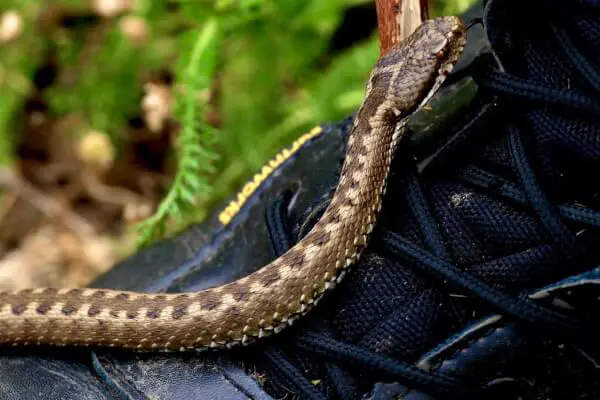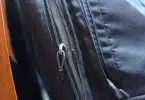Let’s be honest; virtually every one of us finds snakes impossibly scary. It is not just about how they look which sends the chills down the spine but also their capacity to inflict injuries or even fatalities.
Yet an encounter doesn’t have always have to mean death for the snake. Nor should you leave everything to “fate” when you are living or camping out in an area infested with many snakes. You could make a safe snake trap and ensure everyone emerges out of the encounter alive.
Some snakes are completely harmless and are more of a nuisance than anything, and some snakes are extremely venomous so we want to stay away from them as best we can. But sometimes snakes need to be dealt with – and capturing snakes using traps is the best method of dealing with them.
See also: Snake Bite First Aid: How To Manage An Unpleasant Encounter
Snakes are a part of a healthy ecosystem so we do not want to be completely rid of snakes altogether, however, we would like them away from our immediate living areas unless they are pet snakes, of course.
There can be a few different scenarios which can find you needing to trap a snake. Perhaps you own a large property or even a house in the suburbs, and you find yourself with frequent slithering unwanted visitors or you could be a snake lover and have a pet snake that has managed to evade you and escape.
Sometimes you may not even physically see the snake but just suspect that there is one – after all your pet chickens aren’t disappearing on their own! No matter the reason, the important thing is to have a way of capturing a snake safely and effectively using snake traps that work – you do not want to kill the snake or make it angry and aggressive.
How to Make a Snake Trap: Different Ways of Doing It
There are quite a few different snake traps available. Some of these are rudimentary and you can simply DIY. There is no reason to have to go to a great deal of effort to trap a snake; often the simple traps are the best. Different traps are good for different circumstances, so here are the main traps that you can use and a brief outline so you can choose the trap that best suits your needs.
#1 Bottle Trap
Perfect for: Indoor use, small snakes.
Difficulty: Low.
The bottle trap is the most basic snake trap, and is perfect to capture small snakes. An example of a good time to use a bottle trap is if you have a pet snake that has escaped and you are struggling to catch it. You still need to be careful, as there are no guarantees that the snake that you are hunting will necessarily be the snake that you catch – you may surprise yourself and find a different snake caught.
The only tools that you will need are a bottle (a water bottle or empty juice bottle), scissors and bait (such as a frozen mouse). Simply cut a hole in the bottle, put the bait inside the bottle and wait for the snake to slither inside. Once the snake is in the bottle, it will not be able to escape so then you have yourself a successfully captured snake!
#2 Wooden Box Trap
Perfect for: Indoor or outdoor use, larger snakes.
Difficulty: Medium.
The wooden box trap is the go-to option if you have a bigger snake problem, whether it be inside your house (such as in your basement), or anywhere outside. Basically, it is a large wooden box which has bait inside which attracts the snake. When the snake goes into the box, it closes on the snake, which effectively traps it inside.
The benefit of a box trap is that it is easy to see when a snake is caught (will be visible from the outside) and it is very humane. Simply relocate the entire box, open it up and let the reptile go free at a designated location. They can be made at home quite easily (if you have the tools), or they can be purchased as they are. They are also good to use in any weather as they are heavy and won’t be blown away easily.
#3 Wire Cage Snake Trap
Perfect for: Indoor or outdoor use, larger snakes.
Difficulty: Medium.
The wire cage snake trap is also commonly known as a Funnel Door trap. It is basically a bigger version of the bottle trap and works in the same way – there are one or two entrances (that resemble a funnel – hence the name) that the snake slithers through and once it is through, it is stuck. Because it is made from wire, it is easy to see straight away when a snake has been caught, and releasing it is as easy as simply disconnecting it.
Wire cage traps are easy to make with the right tools, and just like the wooden box trap, are available commercially if you prefer to get a ready-made trap. The only real consideration is to think about the size of the entrance – bigger snakes will need a bigger ‘funnel’, however making it too big will give them more opportunity to escape.
You will need to make sure that there is bait inside the cage as this is what stops the snake from escaping – its stomach expands when it eats the bait so you need to make sure that you check the trap before it has a chance to completely digest its food and escape.
#4 Commercial Plastic Box Trap
Perfect for: Indoor use, beginners.
Difficulty: Low
Not all snake traps need to be home made. Perhaps you would prefer the ease of simply purchasing a ready-made snake trap online. Amazon sells a perfectly good and completely humane plastic snake trap and it is perfect for novices in snake trapping. It doesn’t even require bait – it comes with specially designed snake attract dots which actually draw the snake to the trap.
Perfect for those who are against live baiting, it is basically a plastic box which traps the snake, allows it to be safely transported, and is easy to release back into the wild. It can also be reused, which is convenient. The snake is immobilized using a special safe adhesive, so it is recommended for use indoors or in places where other wildlife cannot get caught. To free the snake (or anything else caught); simply spray cooking oil to release the adhesive.
#5 Glue Trap
Perfect for: Indoor and outdoor use, all snakes
Difficulty: Low
Possibly the easiest and most straight forward type of snake trap is the glue trap – it is also the idea behind the previously mentioned commercial plastic box trap. In fact, it is the snake trap preferred by most people because it is so humane and it can be easily adapted to suit any size of snake and environment.
Basically, you only need to purchase the special adhesive. It can either come as actual glue, or as a sticky sheet. You then decide where to place the adhesive and what to put it on.
You can use a box or even a plank of plastic or wood – just make sure whatever you use is large enough to properly trap the snake. A box is preferred simply because it makes handling the snake easier and safer.
The larger the glued area the better to make sure the snake is actually immobilized and not slithering around with a piece of plastic glued to its underbelly. Once the snake is caught, simply use oil to unstick it. Just ensure that no other animals, pets or humans find themselves inadvertently glued.
It is important to note that we are not trying to hurt or kill the snake. When used properly, all of these different traps outlined will effectively and humanely capture the snake, and allow you to free it back into the wild. If you suspect that you are dealing with a highly dangerous or venomous snake, then it is a good idea to get a professional involved.
Venomous snakes can be among the most dangerous animals in the world, so it is not worth risking your life.
How to Trap a Snake: Important Tips
- Know your snakes. If you have some idea of exactly what you are trying to catch, then you will have more luck. For example, if you have a large python living in your basement, then you will not have any success with a small bottle trap. There will be some clues to help you determine the size of the snake in question such as slither marks, skin shedding or things like the number of chickens killed (indicating a larger snake).
- Location of the trap: Different snakes will have different behaviours and, therefore different traps will be best in different locations. For example, if you know that a snake that you are hunting is entering your basement through a particular window or crack in the wall, then plant the trap in that area and you will be much more likely to trap it.
- Bait: Just like fishing or any type of hunting, you are unlikely to have any luck at all trapping a snake without bait – the chance of the snake accidentally slithering into the trap is slim. There is no need to find some extravagant or expensive bait, just use anything that is part of their diet – so small marsupials, birds or eggs. Frozen bait is best simply because it is more humane and hygienic. There are actually special snake discs which attract snakes which can be used. However these are generally not as effective as using actual food.
- Keep within the law. There is a common saying that ‘the only good snake is a dead snake’ but it can actually be illegal to capture and kill some snakes. So make sure that you check the laws in your local area. If you do find yourself in possession of a protected snake, then make sure that you do not harm it and set it free straight away (somewhere far away from you or anyone else).
- Protect yourself. Snakes unsurprisingly are unpredictable and should always be assumed to be dangerous. Never take a chance with a snake; it is just not worth it. If you know or even suspect that there is a snake around somewhere, then make sure that you wear gloves, thick pants and special hunting boots, especially when releasing it.
What to Do After Trapping A Snake
Actually trapping the snake is only part of the process. And often once the snake is successfully trapped, the most dangerous part starts.
Unfortunately, there is no magic button to push that will make the snake disappear once it is in the trap, so you need to have a plan of what to do once it is caught.
- Act quickly: If you have a trap set up, make sure to regularly check it. You do not want to leave a snake in the trap for days at a time, as it is unnecessary and cruel.
- Be careful: Once you have caught a snake, you will quickly learn why some traps are favored over others. Some traps will be easier than others to get the snake released (such as the box traps), so make sure you know exactly how your trap works. Also, make sure you don’t come into contact with the snake itself, as the snake will not care that you are trying to help and will get aggressive because it feels threatened by your presence.
- Release far away: Unless you have trapped your pet snake, then there really is only one thing that you can do once you have trapped a snake – and that is to release it back into the wild. Of course, simply releasing it where you caught it will prove to be pointless, so make sure you take the snake at least 5 – 10 miles away from where it was caught (such as your house or property).
If you release it any closer, then there is a chance it will simply wander back and you will have to start the process over again. Of course, if it is your pet snake, then all you need to do is simply release it back into its enclosure, and make sure that you prevent any future escapes! - Clean and reset the trap: Once you have successfully trapped and released a snake, then the very last step is to clean the trap (if you plan on reusing it) and either put it away for use at a later date, or set it up again to try to catch another snake. Chances are if there is one snake, it will have a mate, so it is always a good idea to reset the trap up just in case to catch its friend.
Most snakes will be happy to be freed but do not expect them to turn around and thank you. As far as they are concerned, you are the enemy and have captured them against their own will. Chances are they were happy where they were and saw no problem in living in your basement or camping area or killing your chickens.
They are reptiles following their instincts. Give them the respect that they deserve, and never underestimate them even if they are tiny in size. Some of the tiniest snakes are also the most poisonous.
In a perfect world, you would set up a trap, trap the snake, drive it far away, open the trap and have it happily slither away never to be seen again. However, this often is not the case, so once you have captured a snake; make sure you have a release plan. Contact the parks department in your county and inquire on the right procedure as well as location where you can release the snakes. See our tips on how to survive being lost in the woods for more options.
There are different reasons for trapping snakes and different methods of doing it. The most important thing to remember is that snakes should never be underestimated. They are actually very intelligent creatures and have a very intense survival instinct. You really need to be able to outsmart and outwit them in order to effectively trap them safely.
If you are in an area that is commonly frequented by snakes, it is a good idea to read up on the types of snakes in the locality as can assist if you in taking the right action when you come into contact with one without warning.
For more tips on how to avoid wild animal attacks, see our earlier piece on this matter.
Preparation is key, and no matter how well designed your trap is, things can sometimes not go according to plan, and so a contingency or ‘plan B’ needs to be set up.
Featured image source: https://unsplash.com/photos/vYReUlZZxpM








